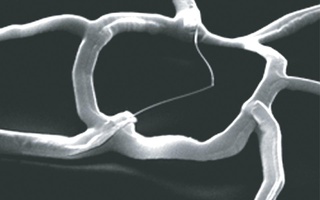When Harvard built the Mark I computer in 1944 to make calculations for the Air Force, it took minutes to do tasks that now take microseconds. Now, Harvard professors are working on conductors so small that electrons sometimes get stuck and bounce back.
Their research focuses on the use of nanowires and nanotubes to construct tiny electronic circuits. These wires and tubes, which can only be seen with the most powerful of microscopes, are so small that just moving them around is a challenge.
"It is a very important step towards building greater devices," says Phaedon Avouris, the manager of Nanometer Scale Science and Technology at IBM's Watson Research Center.
In a discovery that could radically change the way computers are made, Hyman Professor of Chemistry Charles M. Lieber says he has constructed working logic circuits, interconnecting transistors, with nanowires only ten atoms across.
The computer on your desk, by contrast, has wiring in the chips about 400 atoms wide.
Although members of Lieber's research group refuse to discuss the details of how they constructed these tiny circuits, such a discovery could lead to the development of ultra-small computers that consume very little power.
In a pair of papers published in Science magazine earlier this year, Lieber and his group showed how exceedingly small structures can be fabricated and arranged into circuits . This work then led to the group's most recent discovery.
"I am probably more excited than since I first came to Harvard when I was naïve and young," says Lieber.
Read more in News
Council Supports Online Concentration GuideRecommended Articles
-
Women's Lacrosse Drops to TerriersThe end of Spring Break hits all Harvard students hard. Yesterday, the women's lacrosse team had its rude awakening. After
-
Chemistry Professor Garners Prize for Nanotech InnovationHyman Professor of Chemistry Charles M. Lieber recently received this year’s World Technology Award for Materials for his work in
-
Team Develops Nanowire RingsHarvard researchers have developed a breakthrough nanowire technology integrated into high-tech electronic circuits—which, among other things, could help manufacturers significantly
-
Research Assists Cancer TestsHarvard researchers have found new ways of assembling nanowires—ultra-thin wires that have the potential to revolutionize electronics—and a new application
-
Chemistry Researchers Bend NanowiresA group of researchers in the lab of chemistry professor Charles M. Lieber have found a way to synthesize two- and three-dimensional versions of the microscopic strands known as nanowires—a breakthrough that researchers say may greatly increase the reach and applicability of the field by allowing scientists to design vastly more complex structures.
-
 ‘Cyborg Tissue’ Created
‘Cyborg Tissue’ Created













